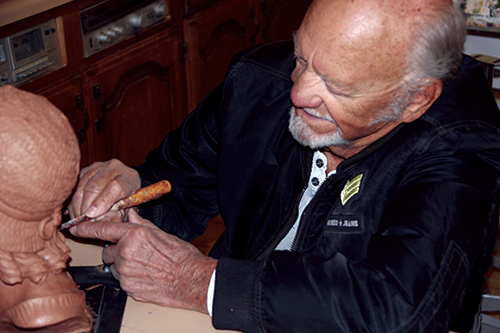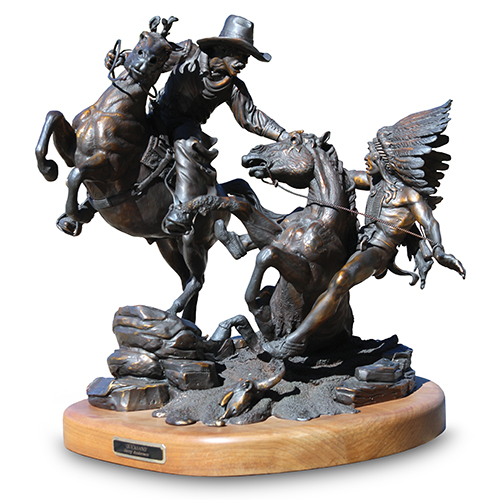
Minutes north of St. George, Utah, off I-15 rests Silver Reef, a ghost of a mining town nestled among red rock formations often canopied by pastel blue skies laced with cotton ball clouds. For more than a quarter century sculptor Jerry Anderson has maintained a studio and gallery there. The synergy between the artist and this ethereal landscape runs as deep as the veins of silver prospectors clawed from the bowels of this red earth in the 1870s and ’80s. Born in Las Vegas, Nev., in 1935, Anderson crisscrossed the West with his well-driller father, an opportunity that sparked his interest in Old West history. He has called southern Utah home for 40 years, while his sculptures have found homes worldwide.
In the 1970s, while Anderson was running a successful steel business in Southern California, he taught himself sketching and painting. Then one day he responded to an improbable matchbook ad inviting those with talent to submit a sample of their work to legendary American artist Norman Rockwell. The ad turned out to be the real deal, and Anderson was accepted into the Famous Artists School, a four-year correspondence course out of Connecticut founded and taught by Rockwell and several other renowned illustrators. Anderson ultimately received a diploma in commercial art and illustration.

His decision to work on bronzes came unexpectedly while mentoring a young man from Idaho doing missionary work in California. The young man, a sculptor, was willing to share his own knowledge and skill set—mold making, foundry work, selection of materials, techniques. Anderson was hooked, and after he and wife Fawn moved to Utah in 1981, he devoted himself to sculpting.
Anderson has created 80 maquettes, or preliminary models, and nearly the same number of large sculptures. One of his most dynamic bronzes (he has also worked in wood and alabaster) is on display at his hometown Silver Reef Museum, housed inside an 1877 Wells Fargo express station on the national and state registers of historic buildings. Just inside the door stands Anderson’s quarter-scale (9 feet long, 3 feet high, 4 feet wide) stagecoach pulled by six horses, which he and brother Ronny created using the complicated and delicate lost-wax method. The sheer size and power of the sculpture causes many first-time visitors to step aside in initial shock. Anderson applies his knowledge of welding, metallurgy and ironwork to showcase his favorite subject—Western horses. His monumental bronze Old Sorrel, depicting a legendary horse that helped settlers build Cedar City, Utah, is the founders’ monument at Southern Utah University. The talented artist also designs jewelry.
Anderson is a member of the Western Art Association, dedicated to the promotion of interest in regional art and artifacts and the preservation of Western heritage. His work has been featured in many prestigious art events, including the Pageant of the Masters, in Laguna Beach, Calif.; Western Artists of America, in Corsicana, Texas; the American/Canadian Classic, in Billings, Mont.; and the Art Expo, in Dallas. When people ask the 85-year-old why he keeps hard at work in his Silver Reef studio, Anderson responds, “I still haven’t done my best piece.” WW





